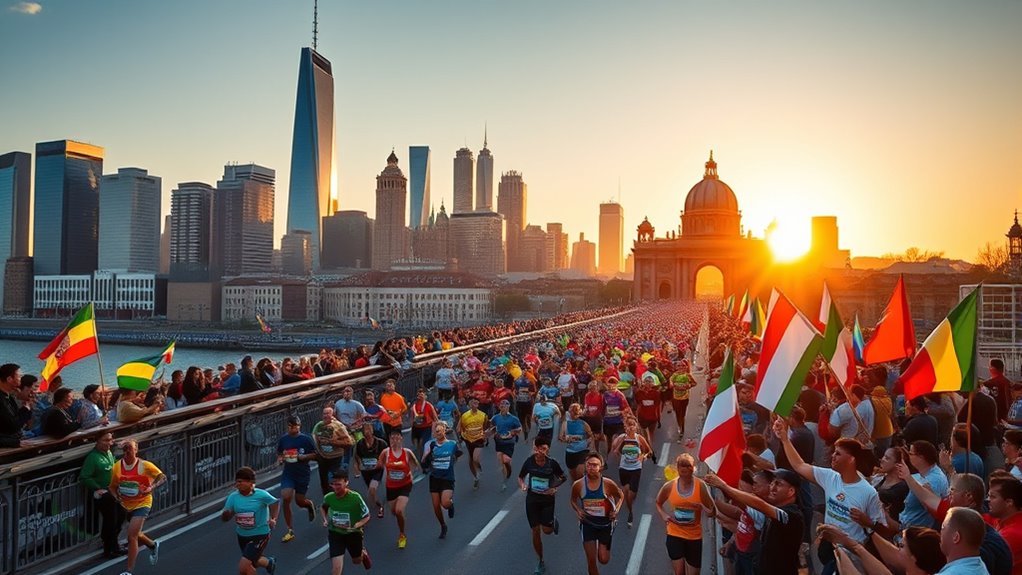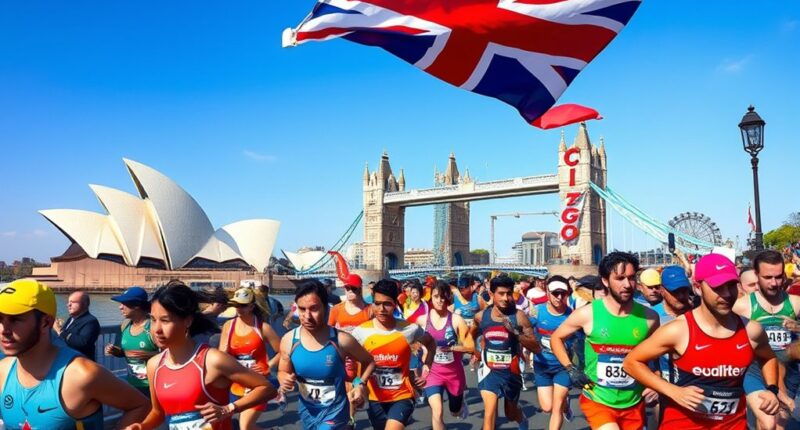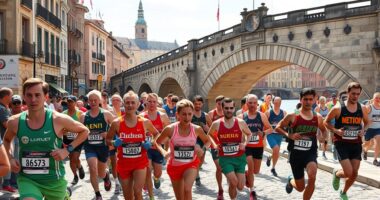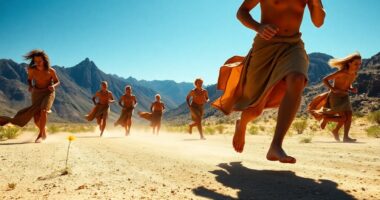The World Marathon Majors are six legendary races, each with its own history and iconic features, from Boston’s historic streets to London’s famous bridges. These races attract top elite athletes who push limits and set records, all while celebrating cultural communities worldwide. Technological advances have helped runners improve over time. If you want to discover more fascinating facts about these thrilling marathons and their legendary moments, keep exploring—they hold endless stories of endurance and achievement.
Key Takeaways
- The Boston Marathon is the oldest annual marathon, starting in 1897, inspiring the creation of the World Marathon Majors.
- The London Marathon runs across iconic bridges like Tower Bridge, offering stunning cityscape views.
- Elite runners often set world records at these races, pushing human endurance boundaries.
- The races celebrate cultural diversity, featuring local traditions and international participants.
- Spectators and volunteers worldwide contribute to the vibrant, festive atmosphere of each event.

Ever wondered what makes the World Marathon Majors so prestigious? It’s not just about running long distances; it’s about the rich race history that each marathon carries and the elite athletes who compete in them. These races have been around for decades, often starting as local or national events before growing into global phenomena. Each marathon has its own unique story, from the historic streets of Boston to the iconic bridges of London. Over the years, they’ve become symbols of endurance, community, and achievement. When you look at their race history, you see a tapestry woven with legendary moments—records shattered, underdog victories, and inspiring comebacks. These stories fuel the passion for the sport and attract the world’s top runners, the elite athletes who push their limits to etch their names into history.
Elite athletes are drawn to the World Marathon Majors because these races are the ultimate test of endurance and speed. They’re not just running for medals; they’re competing for prestige, prize money, and a chance to leave a lasting mark on marathon lore. The competitive field is fierce, with world record holders and seasoned champions *aiming* to outperform each other. Their presence raises the level of competition, making each race unpredictable and exciting. You might be surprised to learn that many of these athletes dedicate their entire careers to succeeding in these events, training for years to peak at just the right moment. Their dedication and talent turn these marathons into battlegrounds where human limits are challenged and redefined. Watching them race is like witnessing history unfold in real-time, with each stride contributing to the ongoing story of the sport.
The race history of the World Marathon Majors also highlights the evolution of running technology, training techniques, and athlete performance. It’s fascinating to see how records have fallen as gear has improved and training has become more scientific. These developments have helped elite athletes run faster and more efficiently, inspiring amateur runners worldwide. Additionally, the advancements in gear and training have significantly contributed to these improvements. The races themselves are cultural festivals, drawing crowds from all over the globe, *hungry* to cheer on their favorites and experience the electric atmosphere. For you, understanding the race history and the role of elite athletes gives deeper appreciation of what makes these events so special. They’re more than just races—they’re celebrations of human perseverance and the pursuit of greatness, woven into the fabric of each city’s identity.
Frequently Asked Questions
Which Marathon Is the Oldest Among the World Marathon Majors?
The Boston Marathon is the oldest among the World Marathon Majors, with a rich history milestone dating back to 1897. As you explore its legendary runners and historic moments, you’ll see how this race shaped marathon culture worldwide. Its enduring legacy attracts runners from all over, celebrating the spirit of endurance and community. Boston’s history milestones make it a true pioneer in the marathon world, inspiring countless athletes over the years.
How Do Weather Conditions Impact Marathon Performances?
While the weather can be a gentle whisper or a challenging roar, it profoundly influences your marathon performance. Climate adaptation becomes essential as temperature effects can either energize or exhaust you. Cool, moderate conditions often boost your endurance, while extreme heat or cold may slow your pace or increase the risk of injury. Being aware of forecasted weather and preparing accordingly helps you navigate these natural factors, ensuring you perform your best regardless of the climate’s mood.
What Are the Qualifying Standards for Elite Runners?
You need to meet the elite standards by achieving qualifying times that vary by age and gender. Typically, these times are faster than the general entry standards and are set by race organizers for each marathon. For example, elite men might need to run under 2:15:00, while elite women might need to finish under 2:35:00. Meeting these qualifying times allows you to compete in the elite field of major marathons.
How Do Runners Qualify for the World Marathon Majors Series?
To qualify for the World Marathon Majors Series, you meet specific qualifying criteria based on elite standards or time-based standards. You need to run a qualifying marathon within a set period, meeting or beating designated qualifying times. These criteria challenge you to demonstrate dedication and distance mastery. By surpassing these elite standards, you earn your place, proving your prowess and passion in pursuit of the prestigious series.
Are There Any Notable Historical Moments Unique to Each Race?
You’ll find each World Marathon Major has its own notable historical moments shaped by race traditions and cultural significance. For example, the Boston Marathon’s historic 1967 “Bobby’s Run” protest highlights its social roots, while the New York City Marathon’s 1970s rise symbolizes urban resilience. In Tokyo, the 2000 race marked Japan’s growing running culture, and Berlin’s 2008 record-breaking finish redefined marathon speed. These moments honor each race’s unique legacy and cultural context.
Conclusion
Think of the World Marathon Majors as a grand adventure, each race a different island filled with unique treasures and stories. As you chase these milestones, you’re like a brave explorer charting new territories, discovering strength and resilience along the way. Remember, every finish line is a beacon guiding you forward. Embrace the journey, and soon you’ll find yourself part of this legendary map—where every step writes a story worth telling.









